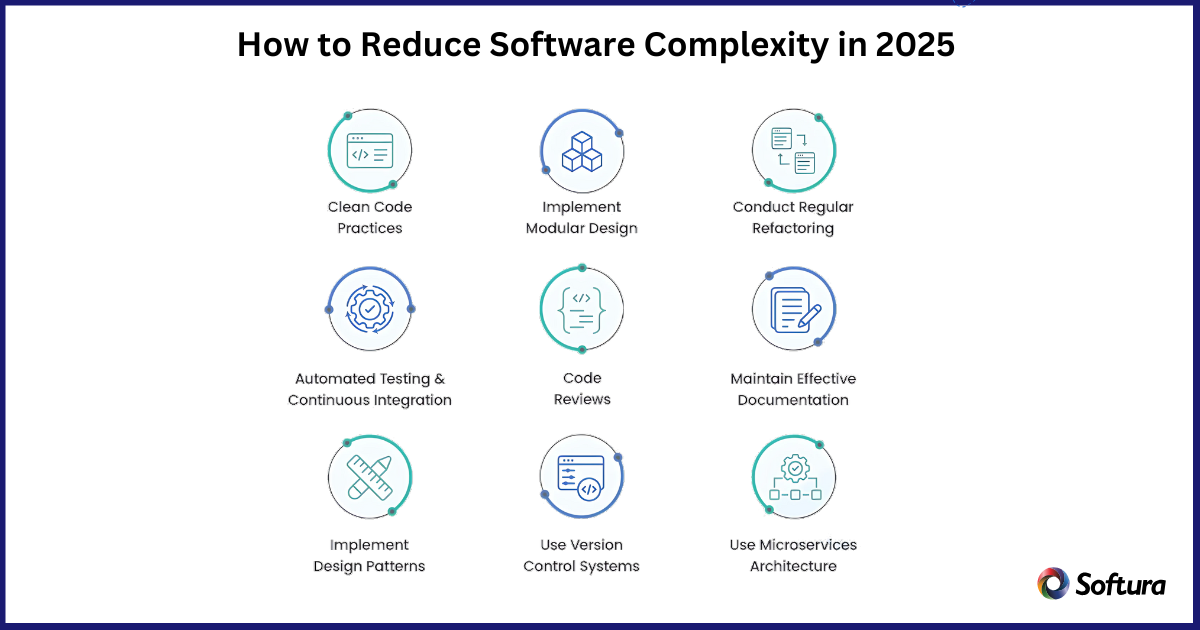"Our integration with the Google Nest smart thermostats through Aidoo Pro represents an unprecedented leap forward for our industry."
- Antonio Mediato, founder and CEO of Airzone.
With technological advancements transforming industries at breakneck speed, complexity in software application development has grown to be one of the biggest challenges for teams worldwide. As we advance into 2025, simplifying the intricacies of software application development is more crucial than ever.
By addressing these complexities, we can create smoother development processes, enhance productivity, and build better products. This blog will delve into the causes of software complexity and provide actionable strategies to mitigate it, giving your team the edge it needs
Complexity in software application development emerges from numerous aspects, including diverse requirements, large-scale teams, intricate systems, and legacy code. As software becomes more ambitious in its goals, the complexity of developing and managing it also grows.
Many developments teams grapple with issues that impede progress and quality, such as inconsistent architecture, scalability challenges, and changing market demands.
Complexity in software application development often impacts not only the efficiency of the development process but also the product's overall performance and maintainability. Let’s explore the reasons behind these challenges in more detail.
"Our integration with the Google Nest smart thermostats through Aidoo Pro represents an unprecedented leap forward for our industry."
- Antonio Mediato, founder and CEO of Airzone.
Simple, intuitive design is at the heart of reducing software complexity. Keeping software components minimal and modular makes them easier to understand and manage. Use principles such as KISS (Keep It Simple, Stupid) and YAGNI (You Aren’t Gonna Need It) to avoid overengineering features that may never be needed.
When designing new features, prioritize user needs and the essential business logic. Reducing unnecessary features and functionalities results in easier maintainability, saving time and reducing the risk of potential bugs.
Using Agile methodologies can effectively address evolving requirements. Agile processes, such as Scrum or Kanban, promote adaptability and iterative progress. Teams can more easily adjust to changing needs, keeping complexity under control by breaking down the development process into more manageable chunks.
Shifting from monolithic architectures to microservices helps in minimizing complexity. With microservices, each component can be developed, deployed, and maintained independently.
This modularity prevents the accumulation of technical debt that is common in monolithic systems and allows teams to isolate and address problems without affecting the entire system.
Microservices also make it easier to scale individual services, which helps tackle scalability demands while maintaining system stability.
Automation serves as a crucial factor in simplifying software development workflows. By adopting CI/CD pipelines (Continuous Integration and Continuous Deployment), you ensure that your software is continuously tested and deployed, reducing human errors and improving code quality.
Automated testing and deployment make it easier to spot issues early, minimizing the chance of small bugs snowballing into larger, more complex problems.

Legacy code can often be a major source of complexity. Rather than trying to completely overhaul legacy systems in one go, take an iterative approach to refactoring.
Gradual refactoring helps modernize your system without overwhelming your team or disrupting ongoing operations. This helps maintain compatibility while introducing new, scalable solutions.
Team communication is crucial in reducing complexity. Use collaboration tools like Slack, Jira, or Trello to maintain transparency and ensure everyone has a clear understanding of the project’s objectives.
Regular standup meetings and retrospectives can ensure everyone stays on the same page, reducing confusion and keeping development on track.
Comprehensive and up-to-date documentation ensures that developers do not have to dig deep into complex codebases to understand how things work. Encourage developers to document their code and maintain a knowledge repository.
Organizing knowledge-sharing sessions can also help spread key insights and reduce the reliance on individual developers for certain knowledge areas.
Managing technical debt is key to maintaining simplicity in software development. While taking shortcuts might be necessary at times to meet deadlines, it’s crucial to plan for addressing those debts promptly.
Keeping technical debt in check helps prevent small issues from evolving into massive, time-consuming challenges down the road.
Generative AI tools like ChatGPT can help developers write boilerplate code faster, assist with debugging, and even provide suggestions for better architecture. By reducing the cognitive load on developers, AI tools can streamline workflows, help avoid errors, and ultimately reduce software complexity
"By analyzing the data from our connected lights, devices and systems, our goal is to create additional value for our customers through data-enabled services that unlock new capabilities and experiences."
- Harsh Chitale, leader of Philips Lighting’s Professional Business.
As we move into 2025, software complexity will continue to challenge even the best dedicated offshore teams. However, by embracing simplicity, modularity, and proactive practices such as automation, Agile, and microservices, teams can mitigate these complexities. Reducing complexity in software application development isn’t about eliminating challenges entirely, but about managing them effectively to enable smoother software development and better end results.
Remember, the key lies in creating scalable and maintainable solutions while continuously improving processes. Complexity is inevitable, but how you manage it makes all the difference.
"By analyzing the data from our connected lights, devices and systems, our goal is to create additional value for our customers through data-enabled services that unlock new capabilities and experiences."
- Harsh Chitale, leader of Philips Lighting’s Professional Business.
Are you ready for your next project?
Unlock your company's full potential with our comprehensive SharePoint consulting services. Contact our experts today to discuss how we can drive your success together.